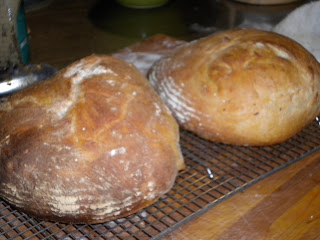Biga
Flour, yeast, water and salt are the ingredients in bread. Sounds simple, and in many ways it is, but the combination of these ingredients and the way they are handled can produce a large variety of different breads, each distinctive from the other. How does this happen? How can these four ingredients produce such a wide diversity of products with different crusts, different crumbs and different tastes?
Let’s start with the flour. Wheat is the most commonly used grain in bread production. It’s main advantage over other grains like millet, barley, corn and rye is its’ gluten proteins. These proteins are compact when dry and insoluble in water, but when they are wetted they change their shape, become elongated, and form and break bonds with other gluten proteins. As they are both plastic and elastic, they allow the bread to change its shape under the pressure of kneading, while at the same time allowing it to return to its original shape when the pressure is removed. The web created by the gluten strands are so strong that when carbon dioxide is released by fermenting yeast, it doesn’t break through the dough, but gets trapped inside, causing the dough to rise.
Flour is composed of the outer bran, the fiber part, the inner endosperm, the starchy and protein part, and the germ, which contains multiple nutrients. Through the milling process, the bran and germ, while full of nutrients and flavor, but which can go rancid in a short period of time, are removed from most bread flours. However, stone ground flours, as the stones crush the grain more thoroughly than steel rollers, contain some bran and germ, thus they make more flavorful breads.
Whole-wheat flours have not been sieved to remove the bran and germ, and while more nutritious than white breads, they are heavier, denser and darker in color. Many whole-wheat recipes contain a combination of white and whole-wheat flour to make then lighter and more appetizing.
The degree to which flour has been refined is known as its “extraction rate.” This number represents the amount of the whole grain that remains after milling. Whole-wheat flours are usually about 90% or greater. White flours are between 70% and 72%, while many European flours are 72% to 78%, making them somewhat more flavorful than American flours.
Different wheat flours contain different amounts of protein. The higher the amount of protein, the “stronger” is the flour. Bread flours, which include 12.5% to 14% protein, make the lightest, highest, chewiest loaves. Cake flours, which have lower amounts of protein (7%), make tender baked goods. All-purpose flours fall between bread and cake flours, in the 11-12% range. King Arthur makes an Artisan European style flour that is 11.7% protein and their White Whole Wheat flour, ground from white, not red, wheat, is a great substitute for the heavier red winter whole-wheat flours.
The other major ingredient that affects the final bread is the amount of hydration used. Bakers use a system known as “bakers’ percentages” in calculating their recipes. In this system, all ingredients are a percentage of the amount of flour in a recipe. So a standard 65% hydration rate means that the water in the recipe is equal in weight to 65% of the flour used. The higher the hydration rate, the softer, less elastic the dough, and an open-textured loaf is produced, while less water produces a firmer, denser loaf.
Next week we’ll discuss yeast, mixing and proofing techniques that also have an impact on the taste and texture of the bread produced.




No comments:
Post a Comment